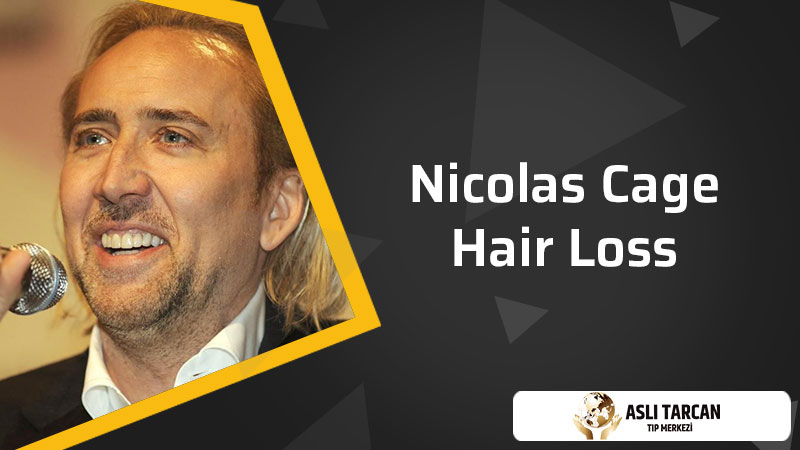Nicolas Cage Hair Loss
Like many famous actors and football players who are in front of the media, people also stand out today with their hairstyles. Besides, many famous people face some hair problems. Among them are the most well-known actors, Nicolas Cage. Nicolas Cage has a reputation as both an actor and a filmmaker. Until now he took so many important parts in films and series such as He has played different roles, such as Raising Arizona, Leaving Las Vegas, and Snake Eyes. The fact that someone so popular in their middle age was suffering from baldness did not go unnoticed. It has also sparked rumours that the actor has undergone a hair transplant in his later years. So what was the cause of Nicolas Cage hair loss and how he got out of it?
Who is Nicolas Cage?
The actor’s full name is Nicolas Kim Coppola, and his birth date is January 7, 1964. The American actor won an Academy Award for Best Actor in 1995. He started his career in the film industry with television shows and rapidly rose to fame. Cage received a bachelor’s degree in Theater, Cinema, and Television from UCLA, where his main aim to be an actor since he was a teenager. He began his acting career in small roles before landing his first major role in Birdy in 1984. The story of two childhood friends who fought in Vietnam received the Special Jury Prize at the Cannes Film Festival. He achieved his greatest success in the 1995 film Leaving Las Vegas.
In 1998, he made film with Meg Ryan in the romance film called City of Angels. For his role as Kaufman in the 2002 film Adaptation, he was nominated for another Academy Award. Cage, who starred in films such as The Weather Man (2005) and Next (2007) during the 2000s, reprised his took part as the main character in the 2007 film Ghost Rider and the 2012 sequel “Ghost Rider 2.”
So What Was The Cause Of Nicolas Cage’s Hair Loss?
When we examine the actor’s filmography, it’s possible to notice the change in his hair. Androgenetic alopecia, or male pattern baldness, is a common hair loss disease among men of Nicolas Cage’s generation. The disorder is hereditary, and it is transmitted down the family line by shared genes that cause hair loss. Many people, including Cage, can see significant hair regrowth when they use the right combination of hair loss treatments. Some Hollywood actors and celebrities suffer from a problem like Nicolas Cage hair loss. They have been confirmed to be attempting to restore their thinning hair. Speculative reports have mentioned actors like John Travolta, Mel Gibson, Brendan Frasier, and Gordon Ramsay.
What Did Nicolas Cage Do To Get Rid Of The Hair Loss Problem?
The mystery surrounding Nicolas Cage hair loss issue remains unsolved. The actor didn’t answer the rumours definitively. However, it is possible to get an idea of the answer to this question by looking at the changes in his hair over time. In previous years, he had a hair problem that was obvious. His hair appears to be thicker at the tip, but it appears to be thinning in some photos. If he did have hair transplants, he did with extreme caution. The outcome was better, but it did not fully resolve his thinning hair issue. However, he had no such problems with his hair in the Netflix documentary. In this documentary, his hair seemed to be more abundant and darker.
If he had a hair transplant, a very specialist surgeon made the changes to his hairline surgically. During a hair transplant, grafts are transferred from one part of the body to the balding area of the scalp. Hair grafts are commonly taken from the donor area of the scalp and can be located on the back and sides. The hair grafts are individually extracted from the donor area of the scalp in the FUE (Follicular Unit Extraction) process, which is the most common hair transplant procedure. Hair grafts may be removed without leaving a longitudinal scar on the scalp since they are harvested separately.
Why Should You Apply for Hair Transplantation Method?
Today, it has shown that hair loss is not only associated with age. Although it is mostly seen in men, permanent hair loss can be seen in women due to genetics, various vitamins and minerals, as well as environmental effects.
DHT (dihydrotestosterone) is a hormone and it causes hair loss (dihydrotestosterone). When the human body releases DHT, hair follicles can no longer develop. Studies showed that it is the primary cause of male pattern baldness. At this time, there is only one viable option for obtaining a permanent solution: hair transplantation.
What is Prosthetic Hair?
In comparison to the past, today’s hair loss issues have a plethora of solutions. The prosthetic hair system is one of them. In addition to consonants, world-famous celebrities use the prosthetic hair process to solve their baldness problems. As a result, many well-known celebrities around the world wear prosthetic hair. There have been rumours that Nicolas Cage may have had a hair transplant, but other opinions are that he used prosthetic hair because he wasn’t sure. An expert eye can see a definite change in rumbling, but the actual hairline seems to have not changed dramatically. With a FUE hair transplant, you can get an incredibly strong hairline, but there’s no certainty that Nicolas Cage has done it.
Only people wear hair prosthetics. The first step of the hair placement process is ‘measurement.’ First of all, a symmetrical hair design mold is created in the area where the person experiences hair loss.
Then, regional hair density is determined, structural characteristics of hair such as color, thickness, delicacy, wavelength are determined in detail. The preliminary design is being sent abroad to get its final version. This prosthesis, which is produced from 100 per cent human hair that comes in 6-8 weeks, is placed in the person’s hair with the help of a special solution. In the final stage, the person’s request, facial structure the hair is shaped accordingly.
Is Minoxidil Hair Loss a Good or Effective Solution?
Minoxidil is a medication used to treat hair loss for decades; originally developed as a treatment for high blood pressure, researchers discovered that it also had a side effect of promoting hair growth. One of the primary benefits of minoxidil is that it has been clinically proven to help regrow hair: the FDA has approved minoxidil hair loss treatment. It works by widening the blood vessels in the scalp, which increases blood flow and nutrient delivery to the hair follicles. This can help stimulate hair growth and improve overall hair health.

Another benefit of minoxidil is that it is easy to use as it comes in a topical solution or foam that you can apply directly to your scalp. You don’t need a prescription to use minoxidil, and it is widely available at drugstores and online retailers. While minoxidil can be an effective treatment for hair loss, it is not a permanent solution. If you stop using minoxidil, your hair loss may return. Before using minoxidil hair loss, speak with your doctor to determine if it is safe and appropriate for you. Your doctor can also help you understand the potential benefits and drawbacks of using minoxidil and help you make an informed decision about your hair loss.



